Almost everyone dreams of owning a residential building, but the future developer is often afraid of unaffordable costs. You can bring your dream closer to reality by building a house with your own hands, which will significantly reduce the estimate. To implement the idea, you need to sensibly assess your skills and physical condition. The construction of a house is carried out according to a single algorithm, which must be studied and followed. The knowledge gained will help to control the work of hired specialists, if they will be involved at any stage.
Project selection and construction documents
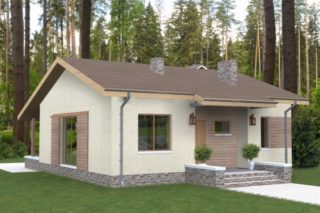
Build a house on your own begins with planning. The intended purpose of housing and its use at different times of the year affects the choice of the project, financial costs and construction time.
When buying a ready-made solution or making it in an architectural bureau, take into account:
- The maximum number of permanently residing people, and for a young family there are plans for the birth of children. A separate room is provided for each family member and potential guests.
- The need for a bathroom on each floor of the building, which is especially important for children and the elderly.
- A complete set of utility rooms - kitchens, furnaces, storerooms, wardrobes. Workshops and a garage are located in the house itself, in the annex or in separate buildings.
- The ability to connect to centralized networks of water supply, sewerage, gas mains of the settlement - this determines the layout and composition of office premises.
- The developer's preferences regarding the architectural form and design.
- The location of the site, its configuration, the requirements of town planning documents in the settlement.
After determining the needs, they begin to manufacture the project and obtain a building permit.
Before designing, they are familiar with the requirements of the Development and Land Use Plan (PLZ), which may differ in each locality. The document limits the height of buildings, the distance from buildings to neighboring areas or roads, sometimes there are mandatory requirements for the building material of the walls, the shape of the roof, etc.
Be sure to take into account the fire rules that regulate the availability of passages for special equipment, the minimum distance to buildings from various building materials.
Failure to comply with the requirements may serve as a reason for the refusal of the supervisory authority when accepting housing for operation and when registering property rights. In case of significant violations, the court may oblige the developer to demolish the object.
To obtain a building permit, an approved project is required. The document can be bought by choosing from ready-made samples, or ordered from an architectural bureau. The cost can range from 10 thousand to 200 thousand rubles.
Construction stages
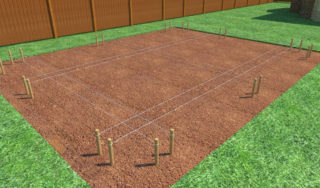
After obtaining permission from local authorities, work begins.
Building a house from scratch step by step with your own hands:
- the layout of the allocated area;
- connecting the construction site of a residential building to the power grid and water supply;
- arrangement of the foundation;
- construction of walls and roofs;
- erection of internal partitions;
- installation of ventilation systems;
- installation of windows and doors;
- sound, heat and waterproofing of each structural element;
- production of electrical wiring;
- entering communications into the house;
- connection of heating, water supply and sewerage;
- putting the house into operation.
The sequence of operations may vary depending on climatic conditions and the availability of individual building structures. For example, in the summer, power grids are laid without waiting for the installation of windows.
Site preparation
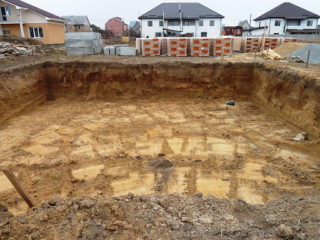
Construction begins with earthworks and excavation.
If a basement is planned, they provide for the possibility of transporting the soil taken out of the pit outside the site.
A layer of fertile soil is stored in a place that will not be contaminated with construction waste - broken bricks, fragments of floor slabs, excess concrete. In the future, the land will be needed to backfill the site.
On clay soils, fertile soil is brought in and this layer is taken into account when choosing the height of the foundation and basement.
Vegetation is removed from the site, trees are uprooted.
Works are carried out in dry weather. If there is dirt on the site, provide a place for washing special equipment (wheels) at the exit points to public roads. Otherwise, the developer faces penalties.
The earth from the pit is used to level the site, fill pits.
Observing all the norms for indents from neighbors and public roads, they mark the site and the foundation pit.
Connecting communications
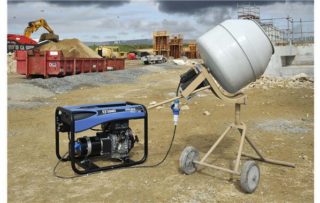
The location of the house on the site is chosen so that it is at a minimum distance from networks and communications.
In the process of connecting gas, water, electricity, the supplying organization will prepare an act of delineating the balance sheet. All equipment located on the territory of the owner belongs to him. Repairs and maintenance will also have to be carried out at their own expense.
The slope of sewer pipes should be 3 cm per meter of pipe length. And if you build a house as far as possible from the highway, you will have to install additional pumps.
Distance from networks will incur additional costs during initial installation.
In any construction, it is necessary to have water for the preparation of solutions and electricity for lighting and powering power tools.
They purchase a gas generator with a capacity of at least 3 kW or install a pole and connect electricity, drawing up documentation for the construction site of a residential building according to a simplified procedure.
The issue of water is solved by temporary connection to a centralized water supply system, digging a well or drilling a well. The most expensive way is to supply water yourself.
Selection and arrangement of the foundation
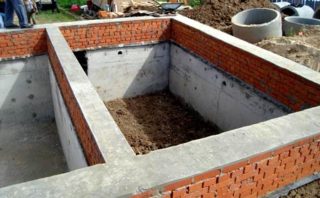
Building a house from scratch with your own hands begins with the arrangement of the base.
Foundations are common in civil engineering:
- tape shallow or shallow;
- deep tape;
- pile;
- columnar;
- slab.
Belt types are divided into monolithic and precast concrete blocks.
The foundation is chosen based on the mechanical composition and characteristics of the soil, the hydrological situation (groundwater level), the total mass and configuration of the building.
The most common type of foundations for private houses is a recessed belt:
- allows you to equip a full basement or basement;
- will withstand the mass of any house;
- simple in design, does not require the use of special equipment during construction, except for digging a pit;
- technological and available in installation for those who build a house with their own hands.
On lands with a high level of groundwater, pile or slab foundations are arranged.
A full calculation is made on the basis of geological surveys, drilling of control pits.
After pouring, concrete gains full strength within 28 days, at which time maximum loads are unacceptable. The waiting time before the start of the construction of the walls can be spent on arranging the site, for example, building a fence.
Building a box house
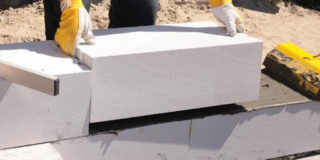
DIY wall construction is available to most developers - skills are acquired quickly.
There are houses with solid (monolithic) walls and frame buildings.
Popular materials for monolithic walls:
- brick - silicate, finishing, ceramic;
- gas silicate or aerated concrete foam blocks;
- timber, rounded logs, lumber;
- aerated concrete, lightweight expanded clay concrete for cast walls;
- permanent formwork.
Prefabricated frame houses are gaining popularity, the outer walls of which are made of oriented strand boards (OSB, OSB), SIP panels, cement particle boards, plywood, siding.
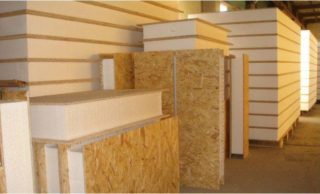
Internal walls are finished with plasterboard, OSB sheets, plywood, clapboard or other sheet materials.
Insulation, vapor and waterproofing membranes are placed between the outer and inner layers.
Exterior finishing options can be:
- plastering and painting;
- wet and ventilated facade systems.
The choice depends on the project and design solution, taking into account climatic conditions.
The roof configuration depends on the region of residence, wind and snow load throughout the year. The roof can be flat or sloped.
The first option is cheaper, less affected by the wind, but will require significant costs and efforts for waterproofing and insulation of the upper floor. In addition, snow does not roll off such a roof on its own. It will have to be removed regularly by hand, as in some regions the mass of snow can reach 150 kg / m² of surface.
To drain the water, a special pipe system must be provided.
Inclined roofs can have one or more slopes, the location of which relative to the cardinal points is chosen based on the wind rose.
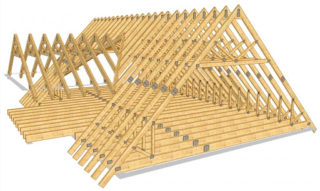
Choosing a house design, take into account the possible options for the construction of the roof:
- one or two-slope;
- hip, hip and half hip;
- multi-gable;
- combined of several types.
The structure of pitched roofs includes rafters, valleys, lathing, hanging or support racks, external covering.
Pitched roofs are more expensive in cost and more difficult to equip. Choosing the correct slope allows the snow to roll freely, while reducing the load on the roof.
The following is used as an external coating:
- slate, sheet polymeric roofing materials;
- steel, copper, aluminum;
- shingles;
- "Flexible" shingles.
When arranging the roof, it is necessary to use safety equipment to prevent falls from a height.
Internal partitions
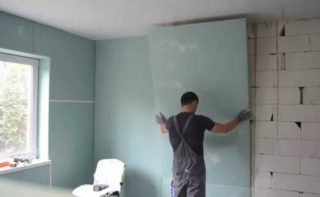
The walls dividing the interior spaces must be strong, resistant to mechanical damage, and provide sound insulation.
The material is:
- silicate or ceramic bricks, finished with plaster;
- foam blocks of any composition;
- wooden products - lining, timber, block house, etc.;
- gypsum plasterboard or cement-particle boards.
As a decoration, wallpaper, plaster, painting, lining, MDF panels, laminated chipboard are used.
Doors and windows
The material of the products is chosen based on functionality and design. Windows and doors can be wooden, plastic, metal.
Installation of doors and windows is carried out only after the final shrinkage of the building, which can take up to 7 months. In order not to interrupt the interior decoration, temporary cheap wooden structures are installed, which will protect the interior from precipitation, drafts, penetration of animals and unauthorized persons.
Wiring
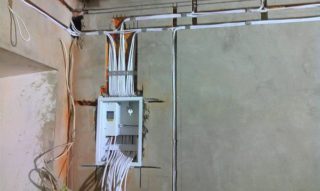
Any developer is capable of making electrical wiring. It is necessary to strictly follow the project and purchase high-quality wiring products.
Particular attention is paid to the quality of cables or wires. Products manufactured according to technical specifications (TU) can have a cross-section 25–30% less than GOST-their analogs. This is not a deception, but legal tolerances.
They purchase copper or aluminum wires with a cross section not less than that provided for in the project.
On fireproof bases, the wiring is hidden with plaster.
Open wiring using cable is allowed.
The cable differs from the wire with double non-combustible insulation. In a wire with two braids, one can be made of combustible material. It is fire hazardous to use such products unprotected.
In frame houses made of combustible materials, the electrical network must be hidden in fireproof pipes, and inside the walls only in metal ones.
When purchasing switching and protection equipment, products are purchased only with a nominal value according to the project. If you install RCDs, difavtomats or circuit breakers of a lower rating, overload trips will occur. A higher rating can cause a fire - the wire will light up before the circuit breaker trips.
Engineering Communication
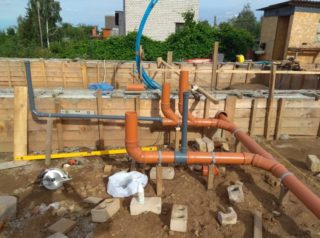
It is necessary to design communications in advance, before arranging the foundation. Otherwise, the technological holes will have to be cut in monolithic reinforced concrete, which is extremely labor-intensive.
The supplying organization (water canal, power grids, gorgaz, etc.) issues technical conditions for connections and approves the project. They also connect to home networks.
The internal wiring of the electrical network and water supply is allowed to be made independently.
For work with gas equipment, a licensed organization must be involved. When designing, it is worth calculating the cost in advance and finding out if there is a physical connectivity.
In some cases, they equip an individual sewage system, make a water supply well. There are many companies on the market offering the installation of gas tanks - individual gas storage facilities.
Ventilation and heating
The ventilation system is performed at the stage of construction of external or internal walls - in this case, it is possible to hide the channels in the walls. In addition, there are options for installing ventilation ducts under false ceilings.
The cheapest and most convenient option for heating and hot water supply is a gas boiler. If the main gas is not available, they are heated by electricity or solid fuel boilers.
The decision to use a particular type of fuel is made after a full calculation of the installation and operation costs.
Commissioning of the object
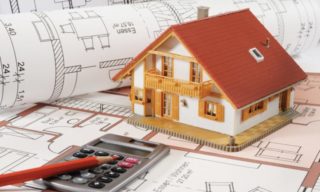
Entry into ownership and the conclusion of full-fledged contracts with supplying organizations in most cases is possible only after putting the house into operation.
A commission is created, the composition of which is determined by local governments with the obligatory involvement of sanitary and epidemiological services and fire authorities.
Until the moment of delivery, it is necessary to keep all certificates of conformity for building materials.
Many land owners are capable of building a house with their own hands, only some types of work require a license or special skills. It is necessary to carefully approach the design. They choose the type of building, most of the work during the construction of which the developer can perform independently.








